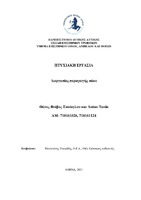Διεργασίες παραγωγής σάκε
Sake production process

Πτυχιακή εργασία
Συγγραφέας
Εσκίογλου, Θάνος Φοίβος
Τούνιν (Tunin), Αντόν (Anton)
Ημερομηνία
2021-07-23Επιβλέπων
Tataridis, PanagiotisΛέξεις-κλειδιά
Σάκε ; Αντοχή σε αιθανόλη ; Ρύζι ; Κάστανα ; Κότζι ; Saccharomyces cerevisiaeΠερίληψη
Η παρούσα έρευνα παρουσιάζει την αρχική προσέγγιση στα προβλήματα και στα ζητήματα
που τίθενται από τις διεργασίες παραγωγής του σάκε, κάτι που δεν αναφέρεται σχεδόν καθόλου
στην ελληνική βιβλιογραφία. Κατά την έρευνα παράχθηκαν δείγματα σάκε με τη χρήση
παραδοσιακής μεθόδου πλήρους κύκλου (από ρύζι σε κότζι και στη συνέχεια από κότζι σε
σάκε). Δείχθηκε η πιθανότητα παραγωγής σάκε με χρήση εναλλακτικών αμυλούχων πρώτων
υλών - κάστανων. Για την πραγματοποίηση αλκοολικής ζύμωσης χρησιμοποιήθηκαν 2
εμπορικά στελέχη ζυμών. Και τα 2 στελέχη έδειξαν υψηλότερη αντοχή σε αιθανόλη απ’ ότι
αναφέρεται από τους παραγωγούς τους. Αναπτύχθηκαν βοηθητικές μέθοδοι της
παρακολούθησης αλκοολικής ζύμωσης (με χρήση δειγμάτων χαμηλότερου όγκου) και της
εκτίμησης αποδοτικότητας της διαδικασίας παραγωγής.
Περίληψη
This study presents the first approach to the sake production technology problems that are still
barely covered by publications in the Greek language. Sake samples have been produced during
the research using the traditional full cycle method (from rice to koji, and then from koji to
sake). The possibility of sake production with the use of alternative starch sources (chestnuts)
was also investigated. Two different commercial yeast strains have been used for the
fermentation. Both strains have shown higher ethanol tolerance than it was quoted by the strain
suppliers. Two auxiliary methods have been developed and implemented, the first being the
ethanol concentration determination protocol that uses small volume samples, and the second
– the method of production efficiency estimation.
